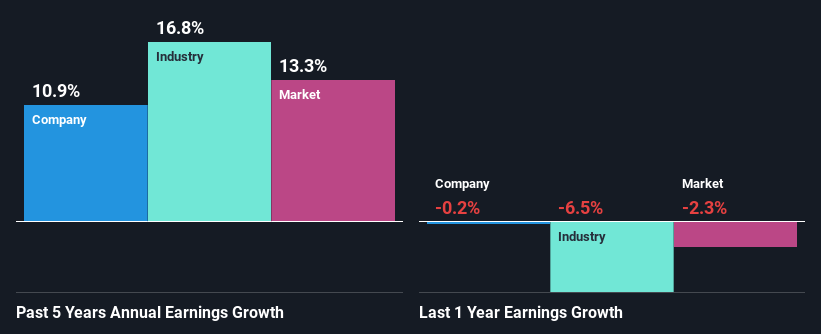Declining Stock and Solid Fundamentals: Is The Market Wrong About Thermo Fisher Scientific Inc. (NYSE:TMO)?
It is hard to get excited after looking at Thermo Fisher Scientific's (NYSE:TMO) recent performance, when its stock has declined 3.3% over the past month. However, stock prices are usually driven by a company’s financial performance over the long term, which in this case looks quite promising. Particularly, we will be paying attention to Thermo Fisher Scientific's ROE today.
Return on equity or ROE is an important factor to be considered by a shareholder because it tells them how effectively their capital is being reinvested. Put another way, it reveals the company's success at turning shareholder investments into profits.
See our latest analysis for Thermo Fisher Scientific
How Is ROE Calculated?
The formula for ROE is:
Return on Equity = Net Profit (from continuing operations) ÷ Shareholders' Equity
So, based on the above formula, the ROE for Thermo Fisher Scientific is:
13% = US$6.0b ÷ US$46b (Based on the trailing twelve months to March 2024).
The 'return' is the income the business earned over the last year. So, this means that for every $1 of its shareholder's investments, the company generates a profit of $0.13.
What Has ROE Got To Do With Earnings Growth?
So far, we've learned that ROE is a measure of a company's profitability. Based on how much of its profits the company chooses to reinvest or "retain", we are then able to evaluate a company's future ability to generate profits. Assuming all else is equal, companies that have both a higher return on equity and higher profit retention are usually the ones that have a higher growth rate when compared to companies that don't have the same features.
Thermo Fisher Scientific's Earnings Growth And 13% ROE
To begin with, Thermo Fisher Scientific seems to have a respectable ROE. Further, the company's ROE is similar to the industry average of 12%. This probably goes some way in explaining Thermo Fisher Scientific's moderate 11% growth over the past five years amongst other factors.
We then compared Thermo Fisher Scientific's net income growth with the industry and found that the company's growth figure is lower than the average industry growth rate of 17% in the same 5-year period, which is a bit concerning.
Earnings growth is an important metric to consider when valuing a stock. The investor should try to establish if the expected growth or decline in earnings, whichever the case may be, is priced in. By doing so, they will have an idea if the stock is headed into clear blue waters or if swampy waters await. Is Thermo Fisher Scientific fairly valued compared to other companies? These 3 valuation measures might help you decide.
Is Thermo Fisher Scientific Efficiently Re-investing Its Profits?
Thermo Fisher Scientific's three-year median payout ratio to shareholders is 6.5% (implying that it retains 94% of its income), which is on the lower side, so it seems like the management is reinvesting profits heavily to grow its business.
Additionally, Thermo Fisher Scientific has paid dividends over a period of at least ten years which means that the company is pretty serious about sharing its profits with shareholders. Based on the latest analysts' estimates, we found that the company's future payout ratio over the next three years is expected to hold steady at 6.5%. Regardless, the future ROE for Thermo Fisher Scientific is predicted to rise to 18% despite there being not much change expected in its payout ratio.
Conclusion
On the whole, we feel that Thermo Fisher Scientific's performance has been quite good. Specifically, we like that the company is reinvesting a huge chunk of its profits at a high rate of return. This of course has caused the company to see a good amount of growth in its earnings. The latest industry analyst forecasts show that the company is expected to maintain its current growth rate. To know more about the latest analysts predictions for the company, check out this visualization of analyst forecasts for the company.
Have feedback on this article? Concerned about the content? Get in touch with us directly. Alternatively, email editorial-team (at) simplywallst.com.
This article by Simply Wall St is general in nature. We provide commentary based on historical data and analyst forecasts only using an unbiased methodology and our articles are not intended to be financial advice. It does not constitute a recommendation to buy or sell any stock, and does not take account of your objectives, or your financial situation. We aim to bring you long-term focused analysis driven by fundamental data. Note that our analysis may not factor in the latest price-sensitive company announcements or qualitative material. Simply Wall St has no position in any stocks mentioned.
Have feedback on this article? Concerned about the content? Get in touch with us directly. Alternatively, email editorial-team@simplywallst.com

 Yahoo Finance
Yahoo Finance 
